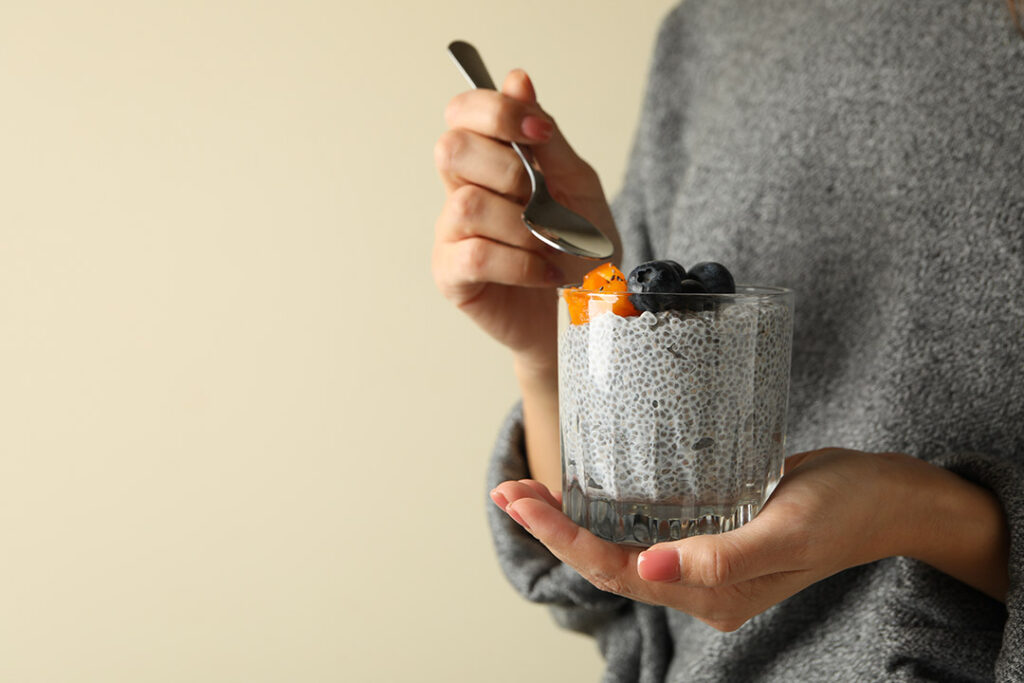Fiber does more for your body than help with constipation. It can help with your overall gut health, blood sugar levels, weight loss goals and more.
If you’re someone who’s concerned about your digestive health, you’re probably familiar with adages like “you are what you eat” and “eat the rainbow.” These are great rules to follow, but there’s a crucial component of a healthy diet that often gets overlooked: fiber.
While fiber is often associated with constipation and moving along sluggish bowels, it also offers tons of benefits for weight management, blood sugar, and overall gut health. But, striking the right balance with your fiber intake is key to enjoying all its benefits. Let’s explore how to use fiber to enhance your digestive health.
What is Fiber?

Before we dive into all the many benefits of fiber, let’s first get a handle on what fiber really is.
Fiber is a type of carbohydrate found in plant-based foods that our bodies can’t digest. Unlike other carbs that break down into sugars, fiber passes through the digestive system relatively intact.
It may seem counterintuitive that something that simply passes through our systems could play such an important role but don’t be fooled—this critical fiber is what keeps your digestive system running smoothly. Without fiber, your digestive system would struggle to function properly, leading to issues like constipation, irregular bowel movements, and an increased risk of gastrointestinal (GI) diseases.
Types of Fiber: Soluble and Insoluble
There are two main types of dietary fiber: soluble and insoluble. Each type functions differently in the body and offers different benefits.
Soluble Fiber
This type of fiber dissolves in water to form a gel-like substance in the digestive tract. It helps to slow down digestion, which makes it easier to manage blood sugar levels and cholesterol. You can find soluble fiber in foods like oats, apples, carrots, and beans.
Insoluble Fiber
Unlike soluble fiber, insoluble fiber doesn’t dissolve in water. Instead, it adds bulk to your stool which helps food move more efficiently through your digestive system. This type of fiber is found in whole grains, nuts, beans, and vegetables like cauliflower and potatoes.
How Fiber Affects Digestive Health

While fiber plays a few different roles in digestion, it mostly acts like a broom that sweeps through your digestive tract, keeping everything clean and moving smoothly. This “tidying up” has a ripple effect that leads to several other important benefits for your digestive system.
Fiber Improves Bowel Regularity
One of the most well-known benefits of fiber is its ability to promote regular bowel movements. By adding bulk to your stool, fiber helps prevent constipation and ensures that waste moves through your digestive system at a healthy pace.
Fiber Relieves Constipation
If you’ve ever experienced the discomfort of constipation, you know how important it is to keep things moving. As we learned above, fiber is one of the best natural remedies for preventing constipation, but it can also help relieve constipation if things do come to a halt. Increasing your fiber intake helps move your stool through the digestive tract faster and more comfortably so you can get back on your normal schedule.
Fiber Balances Gut Microbiota
Fiber doesn’t just help with bowel movements—it also feeds the good bacteria in your gut. These bacteria play a crucial role in maintaining a healthy digestive system, and they thrive on fiber. By nourishing your gut microbiota, fiber supports the big picture of your digestive (and whole body) health.
4 Fiber Benefits Beyond Digestion

Fiber is great for staying regular, but there are many other health benefits that fiber offers. Here are just a few you can look forward to when you up your fiber intake…
Fiber Supports Weight Management
If you’re on a mission to manage your weight, fiber can be your secret weapon. High-fiber foods are often more filling, which means you can feel more satisfied with fewer calories. Plus, since fiber slows down digestion, it helps prevent sudden spikes and drops in blood sugar levels, which can also help to reduce pesky cravings that sabotage your diet.
Fiber Helps Manage Blood Sugar Levels
For those with diabetes or anyone looking to stabilize their blood sugar, fiber can be a huge help. Soluble fiber, in particular, helps slow the absorption of sugar, leading to more gradual increases in blood sugar levels. This can be incredibly beneficial for managing diabetes or preventing blood sugar spikes after meals.
Fiber Reduces Harmful Cholesterol Levels
Fiber, especially soluble fiber, has been shown to reduce levels of LDL cholesterol—the “bad” cholesterol that can contribute to heart disease. It does this by binding to cholesterol particles and helping to remove them from the body before they can enter the bloodstream.
Fiber Lowers the Risk of Gastrointestinal Diseases
Low-fiber diets are associated with gastrointestinal diseases like diverticulitis, hemorrhoids, and even colon cancer. Reduce your risk by increasing the amount of dietary fiber you eat daily. By keeping your digestive system healthy and functioning properly, fiber helps to protect against these and other conditions.
Daily Fiber Recommendations
There’s no question – if you want to improve your digestive health, you need to take a closer look at your fiber intake. But how much fiber do you need to reap these benefits? And what happens if you take too much?
Recommended Daily Intake
The amount of fiber you need depends on your age and gender. On average, women should aim for about 25 grams of fiber per day, while men should target around 38 grams.
Signs of Fiber Deficiency
Are you getting enough fiber? If not, you may be setting yourself up for a higher risk of digestive issues like constipation, bloating, and GI issues. You might also notice that you feel hungry more often or struggle to reach your weight loss goals, as fiber helps you feel full. Over time, a lack of fiber can increase your risk of developing chronic conditions like heart disease and type 2 diabetes. Check with your AlignLife functional nutritionist to get clear on how to adjust your fiber intake to stay healthy.
Consequences of Low Fiber Intake
Consistently low fiber intake can lead to chronic constipation, increased risk of colon cancer, and higher cholesterol levels. It can also contribute to weight gain and make it more difficult to manage blood sugar levels
Excessive Fiber Intake: How Much is Too Much?
While fiber is essential, it’s possible to have too much of a good thing. Overloading on fiber can lead to bloating, gas, and even diarrhea. If you experience these symptoms, it might be a sign that you’re consuming too much fiber too quickly, or that you need to drink more water.
Fiber can also affect how well your body processes other nutrients. Make sure you’re not sacrificing protein, healthy fats, or other vital nutrients in your quest to eat more fiber. A balanced diet is key to overall health.
When to Seek Professional Medical Advice
If you’re experiencing severe digestive discomfort or symptoms like persistent bloating or constipation, it’s a good idea to consult a healthcare professional, like your AlignLife functional nutritionist. They can help you check your fiber intake and make sure you’re getting the appropriate amount for your body and health goals. They can also help determine if there are other factors at play that could be at the root of your digestive symptoms.
The Best Sources of Dietary Fiber

Ready to boost your fiber intake? The good news is that eating more fiber is easy – fiber is found in a wide variety of delicious, natural foods which makes it an accessible way to improve your diet and well-being.
Top High-Fiber Foods
Fruits, vegetables, whole grains, legumes, nuts, and seeds are all excellent sources of dietary fiber. Some particularly high-fiber foods include:
- Fruits: Apples, pears, berries, and oranges
- Vegetables: Broccoli, Brussels sprouts, and carrots
- Whole Grains: Oats, brown rice, and whole wheat bread
- Legumes: Lentils, black beans, and chickpeas
- Nuts and Seeds: Almonds, chia seeds, and flaxseeds
High-Fiber Snacks to Try
- Apple Slices with Almond Butter: Apples are high in fiber, especially with the skin on, and almond butter adds healthy fats and protein.
- Carrot Sticks with Hummus: Carrots are a good source of fiber, and hummus (made from chickpeas) is also fiber-rich.
- Berries with Greek Yogurt: Berries like raspberries and blackberries are packed with fiber, and Greek yogurt adds a creamy texture.
- Chia Peanut Butter Smoothie: Made with chia seeds and peanut butter, this chia peanut butter smoothie snack is rich in fiber and omega-3 fatty acids.
- Air-Popped Popcorn: Popcorn is a whole grain and a surprisingly high-fiber snack when prepared without too much butter or salt.
- Trail Mix with Nuts and Dried Fruit: Choose a mix with almonds, walnuts, and dried apricots or raisins for a fiber boost.
- Whole Grain Crackers with Avocado: Whole grain crackers provide fiber, while avocado adds both fiber and healthy fats.
- Edamame: These young soybeans are an excellent source of both fiber and protein.
- Oatmeal Energy Bites: Made with oats, flaxseeds, and a touch of honey, these no-bake bites are a quick, fiber-rich snack.
High-Fiber Meals to Make
- Overnight Oats with Berries and Nuts: Oats, combined with fiber-rich berries and nuts, make for a filling and nutritious breakfast.
- Quinoa with Broccoli and Cauliflower: Quinoa is a high-fiber grain, and adding veggies like broccoli to your quinoa increases the fiber content.
- Lentil Soup: Lentils are incredibly high in fiber, and adding vegetables like carrots, celery, and spinach boosts it even more.
- Brown Rice Stir-Fry with Broccoli and Tofu: Brown rice is a whole grain rich in fiber, and broccoli adds even more, while tofu provides protein.
- Whole Wheat Pasta with Spinach and Tomato Sauce: Whole wheat pasta is a great source of fiber, and spinach and tomatoes add to the nutrient content.
- Chicken Burrito Bowls with Beans: Black beans and brown rice are both high in fiber, making this Southwestern chicken burrito bowl both tasty and nutritious.
- Stuffed Bell Peppers with Quinoa and Vegetables: Bell peppers filled with quinoa, black beans, and veggies offer a fiber-packed lunch or dinner.
- Vegetable and Bean Chili: A hearty dish made with a variety of beans (like kidney beans and black beans) and vegetables like tomatoes and bell peppers.
- Barley and Mushroom Risotto: Barley is a high-fiber grain, and mushrooms add both fiber and a rich, earthy flavor.
- Whole Grain Toast with Avocado and Poached Egg: Whole grain toast provides a good amount of fiber, and avocado and egg add healthy fats and protein.
Tips for Incorporating Fiber into Your Diet

Ready to boost your fiber intake? Here are some tips to get started.
1) Increase Your Fiber Intake Gradually
While you may be excited to use fiber to boost your health, it’s important to increase your intake gradually. Adding too much fiber too quickly can lead to digestive discomfort, such as bloating and gas. Start by adding one high-fiber food to your diet each day, and gradually increase from there.
Need support finding the right balance? Reach out to your AlignLife chiropractor or nutritionist to get a meal plan that helps you make the transition seamlessly.
2) Stay Hydrated
Fiber works best when it has enough water to absorb, so staying hydrated is key. Aim to drink plenty of water throughout the day, especially as you increase your fiber intake. This will help prevent constipation and keep your digestive system running smoothly.
3) Read Nutrition Labels Carefully
When shopping for packaged foods, take a moment to check the nutrition labels for fiber content. Look for foods that provide at least 3-5 grams of fiber per serving, and try to choose whole grain options whenever possible. Also, be sure to look for sources with both soluble and insoluble fiber to stay balanced.
Level Up Your Digestive Health with AlignLife

When your digestive system is happy, you’re happy. Getting enough fiber through quality sources is a simple yet powerful way to make that happen.
At AlignLife, we’re here to support you on this journey to better health through improved nutrition, proper spinal alignment, preventative wellness, and more. Schedule a visit with us today for a spine check and to discuss how proper nutrition, including adequate fiber intake, can help you feel your best.



